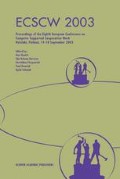Abstract
This paper is about finding explicit and implicit connections between people by mining semantic associations from their email communications. Following from a socio-cognitive stance, we propose a model called HALe which automatically derives dimensional representations of words in a high dimensional context space from an email corpus. These dimensional representations are used to discover a network of people based on a seed contextual description. Such a network represents useful connections between people not easily achievable by ‘normal’ retrieval means. Implicit connections are “lifted” by applying latent semantic analysis to the high dimensional context space. The discovery techniques are applied to a substantial corpus of real-life email utterance drawn from a small-to-medium size information technology organization. The techniques are computationally tractable, and evidence is presented that suggests appropriate explicit connections are being brought to light, as well as interesting, and perhaps serendipitous implicit connections. The ultimate goal of such techniques is to bring to light context-sensitive, ephemeral, and often hidden relationships between people, and between people and information, which pervade the enterprise.
Access this chapter
Tax calculation will be finalised at checkout
Purchases are for personal use only
Preview
Unable to display preview. Download preview PDF.
References
Ackerman, M. and McDonald, D. (1996): ‘Answer Garden 2: merging organizational memory with collaborative help’. In Proceedings of the ACM Conference on Computer-Supported Cooperative Work (CSCW), 1996
Bruza, P.D and Song, D. (2002): ‘Inferring query models by computing information flow’. In Proceedings of the 11 th International Conference on Information and Knowledge Management (CIKM 2002) ACM Press, pp.260–269.
Burgess, C., Livesay, K. and Lund, K. (1998): “Explorations in context space: words, sentences, discourse”. Discourse Processes, v25, pp.211–257
Ducheneaut, N.B. (2002): ‘The social impacts of electronic mail in organizations: a case study of electronic power games using communication genres’. Information, Communication and Society, v5, n2, pp. 153–188
Ducheneaut, N.B. and Bellotti, V. (2002): ‘Ceci n’est pas un objet? Talking about things in email’, forthcoming in a special issue of the Journal of Human-Computer Interaction
Freyd, J. (1983): “Shareability: the social psychology of epistemology”, Cognitive Science, v7, pp.191–210
Gabbay, D. and Woods, J. (2000): ‘Abduction’, Lecture notes from ESSLLI 2000 (European Summer School on Logic, Language and Information). Online: http://www.cs.bham.ac.uk/~esslli/notes/gabbay.html
Gärdenfors, P. (2000): Conceptual Spaces: the Geometry of Thought. MIT Press, London, 2000
Jones, Q., Ravid, G. and Refaeli, S. (2001): ‘Information overload and virtual public discourse boundaries’. In INTERACT, Eighth IFIP TC.13 Conference on Human-Computer Interaction, Japan IOS Press
Karypis, G. and Han, E-H. (2000): ‘Concept indexing: a fast dimensionality reduction algorithm with applications to document retrieval & categorization’. University of Minnesota, Department of Computer Science, Technical Report #00-016
Kautz, EL, Selman, B. and Shah, M. (1997): ‘ReferralWeb: combining social networks with collaborative filtering’. In Communications of the ACM, v40 n3, March 1997
Kimble, C, Hildreth, P. and Grimshaw, D. (1998): ‘The role of contextual clues in the creation of information overload’. In Proceedings of the 3 rd UKAIS Conference. April 1998, Lincoln University, McGraw Hill, pp.405–412
Landauer, T.K., Foltz, P.W., and Latham, D. (1998): ‘Introduction to Latent Semantic Analysis’. Discourse Processes, v25, pp.259–284
Lewis, D. and Knowles, K. (1997): ‘Threading electronic mail: a preliminary study’. Information, Processing and Management, v33 n2, pp.209–217 LTCHUNK (software): online (6 May 2003) http://www.ltg.ed.ac.uk/software/index.html
Lund, K. and Burgess, C. (1996): “Producing high-dimensional semantic spaces from lexical cooccurrence”. Behavior Research Methods, Instruments & Computers, v28(2), pp.203–208
Mikheev, A. (2000): ‘Document centered approach to text normalization’. In Proceedings of SIGIR’ 2000, pp. 136–143.
McArthur, R. and Bruza, P.D. (2003a): ‘Dimensional representations of knowledge in online community’, in Ohsawa, Y. (ed.) (2003, in press) Chance Discovery, Springer-Verlag
McArthur, R. and Bruza, P.D. (2003b): ‘Discovery of tacit knowledge and topical ebbs and flows within utterances of online community’, in Ohsawa, Y. (ed.) (2003, in press) Chance Discovery, Springer-Verlag
Nardi, B. and Engström, Y. (1999): ‘A web on the wind: the structure of invisible work’. In Nardi, B. and Engström, Y. (eds) Computer-Supported Cooperative Work, v8 nl–2
Nardi, B., Whittaker, S., and Schwarz, H. (2000): ‘It’s not what you know, it’s who you know: work in the information age’. First Monday, v5, n5, May 2000. Online: http://firstmonday.org/issues/issue5_5/nardi/index.html
Nonaka, I. and Takeuchi, H. (1995): The Knowledge-Creating Company, OUP, New York
Ogata, H. and Yano, Y. (1998): ‘Collecting oganisational memory based on social networks in collaborative learning’. In WebNet, pp.822–827
Perry, J. (1997): ‘Indexicals and demonstratives,’ in A companion to the philosophy of language, Hales, B. and Wright, C. Eds. Oxford: Blackwell, 1997, pp.593–595.
Perry, J. (1998) ‘Indexicals, contexts, and unarticulated constituents’, in Proceedings of the 1995 CSLI-Armsterdam Logic, Language and Computation Conference. Stanford: CSLI Publications, 1998
Schwartz, M. and Wood, D. (1993): ‘Discovering shared interests among people using graph analysis of global electronic mail traffic’. In Communication of the ACM, v36, n8, 1993
Author information
Authors and Affiliations
Editor information
Editors and Affiliations
Rights and permissions
Copyright information
© 2003 Springer Science+Business Media Dordrecht
About this paper
Cite this paper
McArthur, R., Bruza, P. (2003). Discovery of implicit and explicit connections between people using email utterance. In: Kuutti, K., Karsten, E.H., Fitzpatrick, G., Dourish, P., Schmidt, K. (eds) ECSCW 2003. Springer, Dordrecht. https://doi.org/10.1007/978-94-010-0068-0_2
Download citation
DOI: https://doi.org/10.1007/978-94-010-0068-0_2
Publisher Name: Springer, Dordrecht
Print ISBN: 978-94-010-3994-9
Online ISBN: 978-94-010-0068-0
eBook Packages: Springer Book Archive

